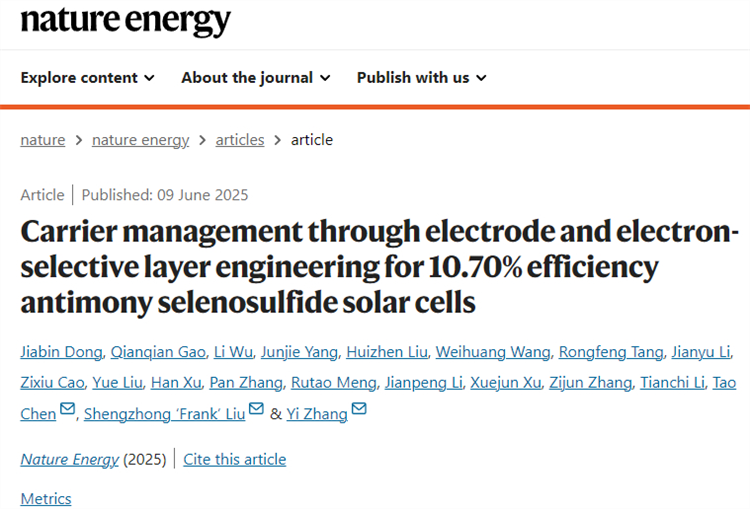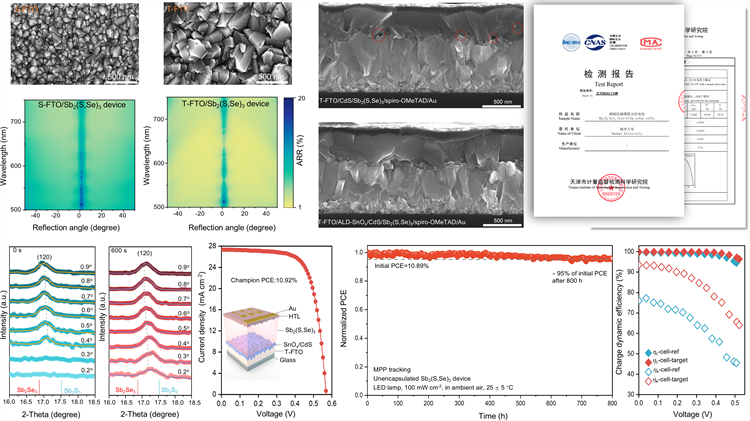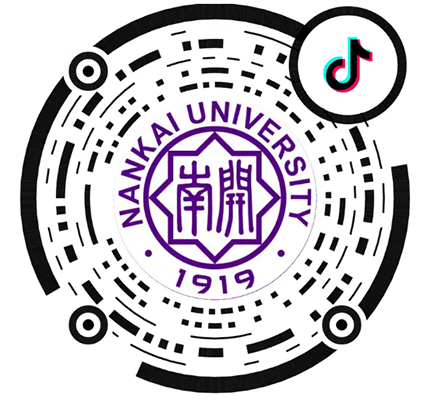Nankai University Team Makes Breakthrough in the Field of Antimony Selenosulfide Solar Cells
On June 9, Nature Energy published online the important progress made by the research group led by Prof. Zhang Yi of the College of Electronic Information and Optical Engineering of Nankai University, in collaboration with the team of Prof. Chen Tao of the University of Science and Technology of China, and the team of Prof. Liu Shengzhong of Dalian Institute of Chemical Physics, Chinese Academy of Sciences, in the field of antimony selenosulfide solar cells.

The study is entitled Carrier management through electrode and electron-selective layer engineering for 10.70% efficiency antimony selenosulfide solar cells. The teams conducted in-depth research into the key scientific problem of carrier loss in antimony selenosulfide (Sb2(S,Se)3) solar cells, and innovatively came up with a multi-dimensional efficient carrier management strategy, which achieved efficient carrier generation, extraction and transport through collaborative optimization of transparent electrodes and electron-selective layers. The fabricated Sb2(S,Se)3 solar cells not only obtain a certified efficiency of 10.70% (the highest value so far for this kind of solar cell), but also exhibit excellent long-term stability. This breakthrough provides a new research paradigm for the development of Sb2(S,Se)3 photovoltaic technology.
Sb2(S,Se)3, a promising photovoltaic material, has both excellent photoelectric properties and chemical stability, with theoretical power conversion efficiency of more than 30%, and is therefore an ideal candidate for the development of high-efficiency, non-toxic and stable solar cells. Nevertheless, there is still a significant gap between the actual certified efficiency of Sb2(S,Se)3 solar cells and the theoretical value. To promote the development of inorganic thin-film photovoltaic technology, a key scientific issue and technical challenge is to deeply explore the preparation process of Sb2(S,Se)3 materials, reveal the efficiency limitation mechanism of its devices, and realize the controlled preparation of high-efficiency and stable Sb2(S,Se)3 solar cells.
Prof. Zhang Yi's research group has long been committed to the research into the high-performance inorganic copper-based and antimony-based semiconductor optoelectronic devices. The team has made a series of breakthroughs in the process of exploration of new inorganic antimony selenosulfide material systems. The team has made significant progress in such areas as a new strategy for preparation of Sb2(S,Se)3 absorber layer (Adv. Electron. Mater 2019, 5, 1800683), low-cost and high-quality controllable preparation of Sb2(S,Se)3 absorber layer (Small 2023, 19, 2206175), and absorber layer energy band structure regulation (Adv. Funct. Mater. 2024, 34, 2309764; Angew. Chem. Int. Ed. 2024, 63, e202406512). On this basis, the research group and the cooperative partners made further breakthroughs and revealed the key factors restricting the performance of Sb2(S,Se)3 solar cells, namely the low photon-generated carrier yield due to light reflection loss and the deterioration of carrier transport at the defect-rich buried interface. Moreover, the team interpreted for the first time the mechanism of how spatial component inhomogeneity in the absorber layer was formed through multi-scale component characterization analysis. These findings are an important theoretical basis for optimizing the performance of antimony selenosulfide solar cells.
To solve this problem, the team adopted a charge carrier management strategy that uses a high-haze fluorine-doped tin oxide transparent conductive oxide film as the front contact substrate of the device, to greatly suppress the wide-angle light reflection loss and maximize the generation of photon-generated carriers. Further, in order to address the buried interface issues caused by the textured substrate surface, which leads to abundant viods and shunt paths, the research team introduced the SnO2 interface layer at the Textured-FTO/CdS interface using techniques such as atomic layer deposition, chemical bath deposition and spin-coating. This greatly improves charge transport and significantly suppresses carrier recombination at the interface and within the absorber layer. This carrier management strategy results in an overall improvement in PV performance (open-circuit voltage, fill factor, and short-circuit current density), and finally achieves third-party certified antimony selenosulfide solar cells with a power conversion efficiency of 10.7%. This technological innovation also paves the way for the advancement of other thin-film photovoltaic technologies such as cadmium telluride and perovskite solar cells.

Carrier management strategy results in Sb2(S,Se)3 solar cells with certified efficiency of 10.70%
Nankai University is the primary contributing institution for this work. Dong Jiabin, a doctoral student enrolled in the College of Electronic Information and Optical Engineering of Nankai University, is the first author of the paper, and Prof. Zhang Yi of Nankai University, Prof. Chen Tao of the University of Science and Technology of China, and Prof. Liu Shengzhong of Dalian Institute of Chemical Physics, Chinese Academy of Sciences are the co-corresponding authors of the paper.
Link: https://www.nature.com/articles/s41560-025-01792-y
(Edited and translated by Nankai News Team.)









